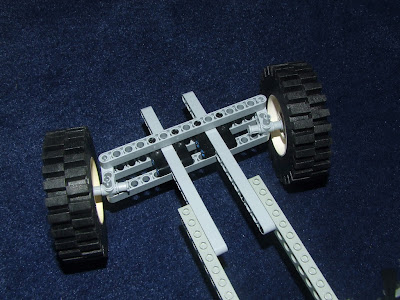While such differential drive works nicely if the model is not too massive or is running on tracks, it becomes an issue with large cars. Regardless of whether the car is AWD or RWD, wheels will tend to skid in the curve, making the steering very unreliable and unstable. (The tracks actually skid as well, but they have more uniform contact with the surface, making them easier to handle.)
One of the simple solutions of this problem is a self-steering chassis. It's perhaps not as refined and sophisticated as some other solutions, but it takes little space, is simple to build and implement, and does not put parts under any serious strain.
This type of chassis is only RWD ― or more precisely, each rear wheel is powered by its own NXT motor. The front wheels, however, can rotate freely and are mounted on the standard steering mechanism, just like usual Lego Technic models. The difference is that the wheel axes are mounted at least a stud or two behind the vertical axes of their control arms/hubs (in automotive terminology, we'd say they have a certain amount of caster). Whether are the control arms connected by a standard equidistant beam or an Ackermann system, is up to you. Theoretically it could work even without a connecting rod, though it would be shaky and unstable, reviving all the problems we are trying to avoid in the first place.
The principle of a self-steering chassis is that the small amount of turning (tangential) force caused by the different speeds between rear wheels should suffice to push the front wheels sideways in the desired direction and turn them, especially while the model is driving when the turning friction is small. Of course, according to the same idea, when the model is driving forward (i.e. the rear wheel motors are driving at identical speeds), the force will straighten front wheels, not much unlike the wheels of a shopping cart.
Additional advantage of a self-steering chassis is its driving power: as opposed to the classic construction where steering and drive are handled by one motor each, most of the time here the model will be powered by both motors, significantly increasing the maximum uphill model can climb against.
However, it's not flawless either; but let's summarize these pros and cons...
▪ GENERAL PROS & CONS
+ Very simple construction
+ Uses no exotic parts
+ Minimum part strain, can withstand serious load
+ Works on any scale, with any wheel and chassis size
+ Does not require a motor itself (allows both rear motors to dedicate entire power to driving the car forward)
+ Very stable drive forward (recenters quickly)
- Requires plenty of grip on rear wheels, and at least a significant amount on front
- Can be unreliable on long, narrow chassis
- Usually impossible to manuever the vehicle in tight, cramped areas (it's difficult to turn the front wheels while stationary!)
- Due to caster, wheels move a lot while steering, requiring an adequate chassis and generous arches
- Difficult to drive straight backwards
- Without adequate special parts, difficult to build with full suspension



cool stuff. maybe switch the second motor from some sort of steering. just cool, and awesome.
ReplyDeleteAmazing post, thanks for sharing such an informative article. Useful and interesting. Take look at this too Book Change Cancellation Driving Test UK. Thanks!
ReplyDelete